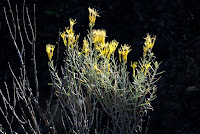 |
| Gold Stars and Columbia River in Back |
This year, our first visit to Rowena was on March 17, a clear, sunny, and somewhat windy day. We arrived before noon, so it was still cool enough for coats and long pants. We saw a herd of deer on the way up to the parking area but luckily no herds of people on this day at the Preserve.
Just steps from the trailhead we spotted carpets of the small and bright Gold Stars, along with large swaths of Grass Widows. The trail was a bit muddy from recent El Nino rains and many of the pools on the plateau were overflowing into small channels down the slope.
Gold Stars (Crocidium multicaule) and Grass Widows (Olsynium douglasii)
Further along we captured Columbia Desert Parsley, Gray's Desert Parsley, Prairie Stars, and Yellow Bells. This loop trail goes out by the cliffs, and has great views of the river and a bird's eye view of Lyle, WA. And speaking of birds, we saw Ravens, a couple of Turkey Vultures, and at least one hawk soaring in the drafts above us. We kept moving, so the vultures ignored us geezers.
Columbia Desert Parsley (Lomatium columbianum) and Gray's Desert Parsley (Lomatium grayi)
Yellow Bells (Fritillaria pudica) and Prairie Stars (Lithophragma glabrum)
On the return route, we encountered more deer, that seemed to be somewhat used to humans in the area. The few oak trees in this area have no leaves yet and a handful of pines are stunted and warped by the wind here.
After a lunch break in the comfort of a nice warm car, we head up the other trail on the south side of the parking area. To prevent damage, the trail is officially closed until May, when things dry out a bit. Instead, we take an old, rocky wagon road trail that skirts the east side of the mountain.
Here we find hundreds of Oaks Toothwarts, more Columbia Desert Parsley, and are surprised to find several blooming Glacier Lily on the sunny slopes. This area is much more treed, with oak at the start, transitioning to firs and pines as we gain elevation. For the next mile or so we see no other hikers on this obscure trail. We stop for a coffee break snack at a nice north-facing clearing, where we get a great view of Lyle, Rowena Crest, and Mt. Adams (Klickitat) in the distance.
Glacier Lily (Erythronium grandiflorum) and Oaks Toothwart (Cardamine nuttallii)
 |
| The old wagon trail |
 |
| Rowena Crest, Mt. Adams, and the Scenic Highway |
After our rest-snack break, we pack up and head back down the trail where we are surprised to find another hiker coming up the hill. We arrive back at the trailhead around 3:30 PDT, ready to shed our boots and head back home.





























